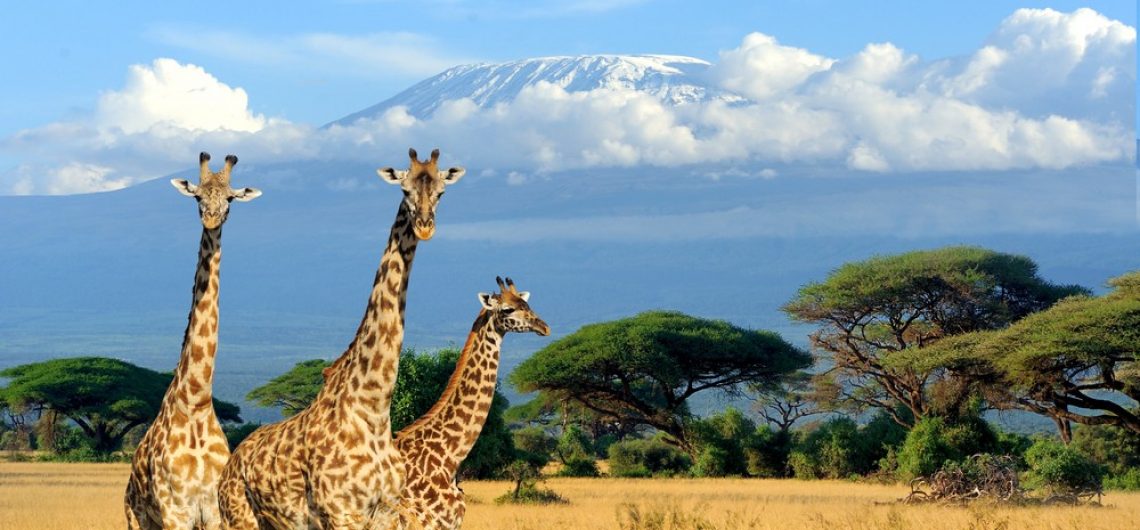Mount Kilimanjaro, the mountain itself may be more popular than Kilimanjaro National Park but there is more to do around the mountain than just climbing it. The Machame route, Umbwe route, Lemosho route, Kilema route for cycling, and many other mountain climbing routes will expose tourists to Africa’s uninterrupted wilderness of montane forest with different plant species, some of which are endemic to this area, and the forest harbors primates like the Thomas monkey. Mount Kilimanjaro is the highest mountain in Africa, with a snow-capped peak measuring 5,895 meters. One of the most popular destinations for Tanzania safari vacations is Kilimanjaro National Park.
In close proximity to the summit of Uhuru Peak, tourists can also choose to visit amazing destinations for day trips like the stunning Lake Challa, a volcanic crater, and glacial ice fields, Materuni Waterfalls, and Kikuletwa/Chemka Hotsprings. Approximately 60,000 people visit the park each year.
Mount Kilimanjaro National Park is located close to Moshi and just around 300 kilometers from the equator; in 1987, the U.N.E.S.C.O. listed the park as one of the world’s historic sites. Customers are rewarded with some of the greatest vacations and adventure trips in Tanzania.
Early in the 20th century, the German colonial authority established Mount Kilimanjaro National Park as a game reserve. A forest reserve was established there in 1921. In 1973, the mountain above the forest line was finally designated as a national park.
The montane forest, which was once a part of the Kilimanjaro Forest Reserve, was added to the Mount Kilimanjaro National Park in 2005. In 2013, the park was chosen as one of Africa’s seven wonders.
So why is Kilimanjaro National Park famous? There are several things that visitors may do at Mount Kilimanjaro National Park, some of which are listed below:
Mountain climbing:
Mountain climbing is the most popular activity on Kilimanjaro, and it will provide you with an exhilarating experience, unlike anything you’ve ever had. The oldest mountain, Shira Peak, was created out of a plateau that offers stunning meadows, a variety of plant types, and plenty of wildlife. Kibo Peak is the tallest peak and is always covered in snow, allowing excellent views of the surrounding cities from a distance.
Game Watching Safaris
Although Mount Kilimanjaro National Park cannot be compared to other national parks in Tanzania like the Serengeti or Ngorongoro, a number of different animals can be seen there, including vervet monkeys, genet cats, honey badgers, aardvarks, baboons, Black and white Colubus monkeys, bushbabies, elands, and elephants, which are primarily found in the Shira Plateau Plains.
Read more about Kilimanjaro wild animals.
Bird Watching:
More than 150 distinct bird species are thought to reside in Mount Kilimanjaro National Park, some of which are migratory and others unique to this region.
White-necked Ravens, resident Black Shouldered Kites, Long-Tailed Trogons, Gabar Goshawks, Blue-Napped Mouse Species, Grey Hornbills, African Fish Eagles, White-Cheeked Barbets, African Pygmy Kingfishers, and Red-Capped Robin Chats are just a few of the birds found on Mount Kilimanjaro. From November to April, when migrating birds from Europe and North Africa are present, is the optimum time to go bird watching.
Read more about the birds of Mount Kilimanjaro
Mountain Biking:
Biking to Africa’s highest mountain through the Kilema route might add an experimental element to a safari; nevertheless, there may be an additional cost for this activity. Three primary stations are present. You will encounter Chagga farmers‘ fields while cycling.
However, this sport should only be undertaken by skilled mountain bikers who are accompanied by a qualified tour leader.
Read more about Biking on Mount Kilimanjaro
Camping:
Camping inside the 32 campsites along the various hiking routes will provide a unique opportunity to explore the bush. The campgrounds provide cozy lodging, outdoor restrooms, and tasty food tailored to your hiking experience.
Read more about the Campsites on Mount Kilimanjaro
Nature hikes with a guide:
The Mount Kilimanjaro forest canopy offers guided nature excursions where visitors may see a variety of primates, including the red-tailed monkey, olive baboon, white and black Colobus monkey, and many plant species, not to mention the expansive views of the Chagga farmlands and nearby villages.
Read more about Tanzania Safaris
Picnicking:
The 13 picnic places in Mount Kilimanjaro National Park include Daraja Refu, Kilimamchele, Wona, Last Water, Machame Halfway, and Jiwe La Mbula, among others, where visitors may engage in this pastime in the untamed nature. Visitors can eat their picnic lunch at one of these locations.
Read more about the day trips around Mount Kilimanjaro
Filming and Photography:
Being the highest free-standing peak in Africa, Mount Kilimanjaro provides expansive views ideal for shooting adventure films. The Snows of Kilimanjaro, one of the most well-known films to win an award, was shot on Kilimanjaro in 1952.
All seasons are good for visiting Mount Kilimanjaro National Park, although mid-June to mid-October and mid-December to mid-March are the greatest.
Check out these amazing Mount Kilimanjaro Pictures
How to get to Kilimanjaro National Park
A two-hour journey will get you to the park from Arusha, a one-hour drive from Moshi, and an hour and a half from Kilimanjaro International Airport.
The majority of lodging options in the Mount Kilimanjaro National Park are bandas, and reservations may be made in advance.
See the best hotels before and after climbing Mount Kilimanjaro
![]()


Comments